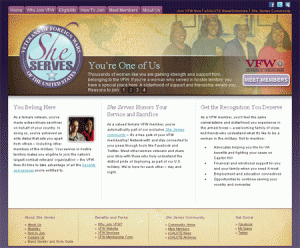Accountability exists in all professions. Physicians are accountable for their diagnoses, receptionists are accountable for the messages they route, and marketers are held accountable for the strategies they propose and the methods they choose to implement them. A good first step in keeping up with what’s expected of us and staying in touch with the primary goals of what it is we’re trying to accomplish is performing a marketing audit.
Interactive & Social
JD Gives VFW’s She Serves Website a Face Lift
There’s an electrifying feeling of excitement here at Johnson Direct today. That’s because we’ve launched a brand new website for the Veterans of Foreign Wars’ female veteran outreach initiative, www.JoinSheServes.org.
We partnered with the VFW in 2008 to develop the She Serves program, and this is actually a second generation web presence for She Serves. The makeover is significant. In fact, anyone who’s been to the original site, may not recognize it at first.
Primarily a recruitment tool, the new She Serves website makes it easy for prospective female veteran members to grasp the real benefits of VFW membership. Not only that, it guides veterans through the application process showing them exactly how to sign up online as a member-at-large. With sisterhood and camaraderie at its core, the website speaks to female veterans of every generation, urging them to become an active member in the nation’s largest combat veterans’ organization. Furthermore, the site is easy to navigate and gives visitors swift access to the news that matters most to female veterans.
The level of research, strategy and planning that went into the 2010-2011 She Serves marketing program and this website is off the charts. We can’t wait to report on the results of our collaboration with the VFW! Stay tuned …
Denise B. Hearden
eMarketing Director
denise.hearden@johnsondirect.com
Use Facebook Ads to Promote Your Brand (HOW-TO)
Over the years, Facebook has evolved from a “yearbook” of sorts for college students to a full-fledged, 400 million user strong social networking site. As any marketing and advertising professional would tell you, the possibility of members from your target market having a Facebook account is relatively high. Luckily for you, Facebook’s advertising platform is easy to use and offers an analytics dashboard to help you track and measure your investment. If you are interested in advertising your brand on Facebook, then this guide is for you. Follow these easy steps and you will be advertising your brand on Facebook and seeing results in no time.
Identify Your Goals
Before creating your ad, targeting you should first think about what you want to accomplish. Some goals we’ve seen in the past include generating revenue, increasing cost per sale, or simply promoting your brand by maximizing visibility. It’s important to think about what you hope to gain so you can accurately measure your return and decide if it’s worth the time and resources.
Design and Develop
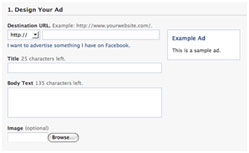 Ad Copy and Creative– After you think about what you’d like to accomplish by advertising on Facebook, it’s time to create the ad itself. Facebook advertisements are located in the far right hand column of the screen after navigating away from the newsfeed. Ads are composed of a headline, copy and imagery to go with your theme. Imagery should be compelling and on-topic. It’s strongly suggested that in any type of online advertising, you use a creative featuring a person’s headshot- they tend to perform better than an object or lesser-known brand logo. In terms of copy, the titles can be 25 characters in length and the body copy of the ad can be 135 characters. It’s best to keep your copy short and to the point – let the imagery you choose do the talking.
Ad Copy and Creative– After you think about what you’d like to accomplish by advertising on Facebook, it’s time to create the ad itself. Facebook advertisements are located in the far right hand column of the screen after navigating away from the newsfeed. Ads are composed of a headline, copy and imagery to go with your theme. Imagery should be compelling and on-topic. It’s strongly suggested that in any type of online advertising, you use a creative featuring a person’s headshot- they tend to perform better than an object or lesser-known brand logo. In terms of copy, the titles can be 25 characters in length and the body copy of the ad can be 135 characters. It’s best to keep your copy short and to the point – let the imagery you choose do the talking.
Landing Page- After clicking on your compelling, well-written advertisement, the user is taken to a landing page where they will decide whether or not they will buy your product. Facebook ads can link to either a Fan Page or an external website. After managing the online ad campaigns for numerous clients, we’ve found that an external, campaign-specific landing page outperforms linking to your brand’s Fan Page. Taking that into consideration, it’s important to keep brand messaging consistent between the creative and the landing page. If your ad uses a logo or object as imagery, add it to your landing page so the user doesn’t feels confident that they clicked on the right advertisement.
Target Your Audience
 One of the many useful features of the Facebook advertising platform is the ability to target your advertising to specific segments. On Facebook, it’s possible to target:
One of the many useful features of the Facebook advertising platform is the ability to target your advertising to specific segments. On Facebook, it’s possible to target:
|
|
The ability to target your audience using this much detail makes advertising as effective, or even more effective, than PPC or traditional online display advertising. With a well thought out goal (remember step one?) and proper targeting, you’ve already qualified traffic to your landing page.
Define Cost Structure
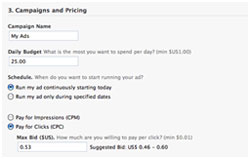 Defining goals, developing effective creative, and targeting your audience is nothing new. It’s been done since the beginning of advertising and is a standard procedure when launching any new campaign. Where advertising on Facebook, or anywhere online for that matter, differs from traditional media buying, however, is in the cost structure. There are two ways to manage your ad spend when running media on Facebook:
Defining goals, developing effective creative, and targeting your audience is nothing new. It’s been done since the beginning of advertising and is a standard procedure when launching any new campaign. Where advertising on Facebook, or anywhere online for that matter, differs from traditional media buying, however, is in the cost structure. There are two ways to manage your ad spend when running media on Facebook:
- Cost Per Click– You pay every time a user clicks on your advertisement. It doesn’t matter whether your ad was served 100 times or 1 million times, you only pay for every click.
- Cost Per Impression– You pay for a set number of impressions, or, ad views. This is measured in multiples of 1,000 and is called a CPM or “cost per million” ad spend.
Choosing a price structure that’s right for you is critical to the success of your campaign. If your goal is to increase brand recognition and don’t have any commercially-tied reason to drive traffic to your landing page other than to promote your name, choosing a CPM model would be the most cost effective. If, however, your success is measured by the number of sales you get via the landing page, starting off with CPC and calculating return would be well-advised.
Launch, Measure, and Repeat
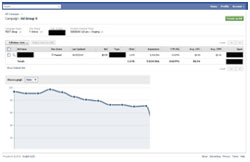 After deciding which cost structure is best suited to your goal, it’s time to launch. Run your ad and regularly monitor it using the dashboard under the “Ads and Pages” tab. Here, you’ll get detailed information on metrics such as bid cost, the number of clicks, average cost-per-click, and more. Narrow down your dashboard by selecting monthly, weekly, or even daily statistics, and dig deeper by exporting reports into csv format and analyzing historical trends.
After deciding which cost structure is best suited to your goal, it’s time to launch. Run your ad and regularly monitor it using the dashboard under the “Ads and Pages” tab. Here, you’ll get detailed information on metrics such as bid cost, the number of clicks, average cost-per-click, and more. Narrow down your dashboard by selecting monthly, weekly, or even daily statistics, and dig deeper by exporting reports into csv format and analyzing historical trends.
After running your ad for a few days, tweak the copy or swap the image and run both ads to find a winner. Running split tests will enable you to find out what works, and what doesn’t work for your audience. If you notice a positive return with advertising on Facebook, keep in mind the fact that users may get used to your ads after several impressions. Remember, marketing is an iterative process, and creativity is king so we always urge our clients to be constantly tweaking their advertisements even after they’ve found one that works.
5 Steps to Optimizing Content for the Web
Feeding the continuous improvement process is the key to search and content marketing success.
Writing and distributing content on the web is as much a science as it is a form of art. Back in high school, we all learned the importance of having a methodology – a series of steps or processes – to follow in order to ensure what we were doing was logical and most importantly, repeatable. Whether you’re looking to increase online sales, generate leads, increase customer retention, or simply create a presence for your company or brand, following a set of steps will help you create compelling content to meet or exceed your goals.
At Johnson Direct, Direct Branding™ is the approach we’ve created to deliver Marketing that’s Measurable. This proven process drives our strategic recommendations and plans — energizing the work we do, from advertising to website development and everything in between. Applying Direct Branding to our clients’ search engine optimization efforts is no exception.
THE FACTS: Search engine optimization is the process of developing and optimizing content to rank and perform better on searches via Google, Yahoo! and Bing. A recent Forester Research study showed that 93% of all web traffic is generated through search engines. Furthermore, a 2010 B2B Online survey showed a projected 57% increase in budgets for “content marketing” making now the best time to throw your hat in the ring and compete on search.
Direct Branding + Search Engine Optimization (SEO)
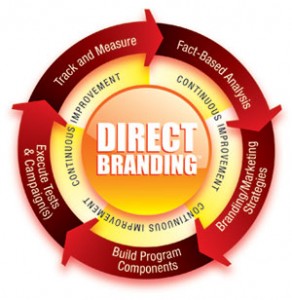 Direct Branding™ is at the core of any traditional or interactive marketing solution offered by Johnson Direct. Whether your organization decides to work with us to improve organic search rankings or not, we advise anyone looking to boost web traffic to take a closer look at our approach.
Direct Branding™ is at the core of any traditional or interactive marketing solution offered by Johnson Direct. Whether your organization decides to work with us to improve organic search rankings or not, we advise anyone looking to boost web traffic to take a closer look at our approach.
The process in planning search engine optimization and content marketing differs little from that of other marketing strategies and tactics – it deserves a strong, persistent commitment in time, resources and energy to produce results.
Here’s a bird’s eye view of the 5-step process, inspired by Direct Branding, brought to you by the interactive team at Johnson Direct.
- Fact-based Analysis
- Branding / Marketing Strategies
- Build Program Components
- Execute Tests & Campaigns
- Track & Measure
SEO / Content Audit: The first step in finding a solution should always be to first define the problem. Whether your issue is stagnant or decreased search traffic, page four rankings, or the inability to track and measure your investment in online marketing, it’s necessary to pop the hood and take a look at what you’re currently doing. Take a look at everything from your sites architecture and navigational structure to the copy on your pages to make sure everything is up to par.
Keyword Analysis: More often than not, we find that our clients don’t have a grasp of their target market. Sure, they may think they know what their users are searching for and where they go to search but unless you look at past results and go through the process of research it’s a shot in the dark. The key is to use a variety of resources, not just one, from keyword research tools to market intelligence. Using a variety research tools will limit the chance of error and give you a better idea of who is visiting your site.
Competitive Analysis: Equally as important as defining your problem and a path of improvement is knowing what you’re up against. Often times, your traditional competitors are not the same as your online competition. Using keyword research and analysis, it’s easy to find out what strategies your top competitors are employing to outperform you in search. Strategic competitive analysis levels the playing field and allows you to compete – even if they have a bigger budget.
The heart of a search engine optimization and content marketing strategy lies in strategy development. When working with our clients, everything is pulled together – SEO best practices, content development suggestions, keyword placement, link building techniques and viral marketing strategy – and rolled up into an easy to understand report so you can be well on your way to improving your visibility in search.
If you read any interactive marketing, SEO, or copywriting blogs, chances are you’ve seen the phrase “content is king” thousands of times. To be honest, it is. Having the knowledge of what works and what doesn’t is one thing but actually developing copy that plays to both your audience AND the search engines is another. Careful planning and cross-departmental collaboration is vital to the success of your content. It doesn’t make sense to have your web developer write your call-to-action or for your PR rep to set up Google Analytics, right? Play to your team members’ strengths and collaborate to produce end results that drive traffic (and revenue) through the roof.
Whether you decide to implement your search engine optimization strategies in-house or utilize our experienced professionals to do it for you, the execution phase is where the magic happens. By following the step by step process outlined in the recommendations report, you will be able to improve the efficiency of your current content and build a foundation of knowledge for future development.
Everything done up to this point is useless without a method of measuring the results. To do this, we’ll optimize your web analytics and implement conversion tracking and goal funnels if you already have an analytics platform. If you don’t already have one, there are both free and premium solutions so you can track performance and assign value to your investment.
Continuous Improvement
We consider search engine optimization an interactive and ongoing process. A lot of marketers go through the steps of improving a process, see positive results, and call it a day. SEO, and any interactive marketing initiative for that matter, requires constant monitoring so you can see improvements as they happen and tweak for further improvements.
Why Johnson Direct?
Johnson Direct is not an interactive shop. We are an experienced, results-oriented full service marketing agency providing our clients with solutions that are proven to increase ROI. By working with a full service agency to deliver interactive solutions, you are choosing to partner with a firm that has a complete grasp of your goals and objectives to form a holistic marketing strategy, be it via interactive or traditional means.
Like anything else in marketing, search engine optimization is an “all-hands-on-deck” process. Involvement is required from all departments – marketing, copywriting, design, web development, and even public relations. Partnering with a multi-channel marketing leader like Johnson Direct will ensure that your search strategy is seamlessly integrated with your other campaigns and organizational goals.
If you’re interested in learning more about our experience in search engine optimization and content marketing, contact us today and speak with one of our interactive marketing pros to learn more about how we can help.
“Like” It or Leave It
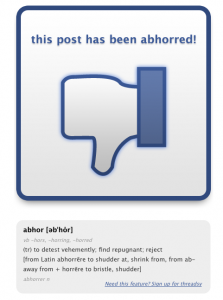
Early last week Facebook changed the ever-popular “Become a Fan” button to “Like”. According to social networking giant, the change was made to “improve your experience and promote consistency across the site.” The “consistency” they’re referring to is the ability to “like” a friend’s status update, uploaded picture, comment on another friend’s wall, or advertisement on the site.
This is what the changes look like now, using the Johnson Direct “Like” page as an example:

While promoting consistency is almost always a good thing, Facebook’s change to their fan system has caused a great deal of headaches to agencies and end-users alike. Here are some reasons why the change may be a bad thing for business:
- Loss of a Branded Term- Prior to launching the Fan Box last July, nobody associated “Become a Fan” with an online entity. Being a fan was simply liking an artist, team, actor, etc. and being actively interested in what they were doing. When Facebook launched the Fan Box, they essentially branded the term and every television, radio, print, and online advertiser with a Fan page added that slogan to their copy. Changing “Become a Fan” to “like” took away that everyday term from association with the social network.
- Frenzied Ad Agencies- Working on the ad agency side, I can only tell you in so many ways, without using NSFW terms, how it negatively impacts client campaigns. First there’s the past collateral- what happens to everything out there now that our clients paid good money for? This could be problematic; especially for the small company that doesn’t have money budgeted for print in Q1 or Q2. Ads that are currently in production need to be put on hold, and both the creative and the marketing teams need to go back to the drawing board increasing the amount of time and resources used by both parties.
- Confused End Users- People don’t like change, especially when it comes to how they use the internet. Every time a client comes to Johnson Direct for a redesign of their website, SEO consultation or anything dealing business-to-consumer marketing, we take a look at how it affects user experience. Having a product or website that brings value to the user is great, but if they get confused about how to use it you have a huge problem. In this case, changing “Become a Fan” to “like” may associate “liking” a status, photo or advertisement to “liking” a company, band or product when they are, according to Facebook, entirely different. For an example, take a look at this post about how a top-ranked ReadWriteWeb article confused users Googling “Facebook login”. I think I’ve made my point!
As time passes we’ll know for sure if this was a good or bad move on the part of Facebook. In the short term it will hurt the ad agencies and small companies with ads in the works but who knows- maybe we’ll make up for it with increased conversions from users mistakenly clicking on our Facebook ads because they thought they were “liking” the company!
